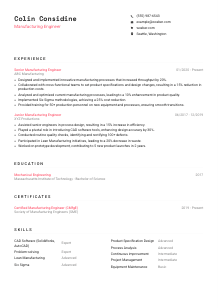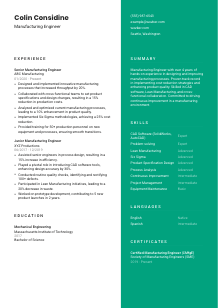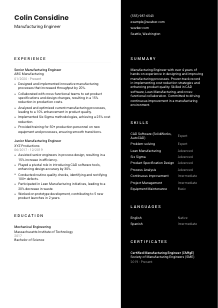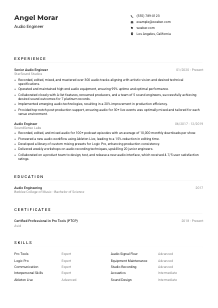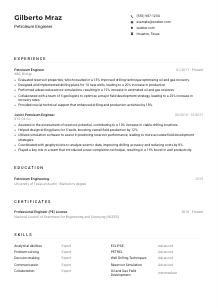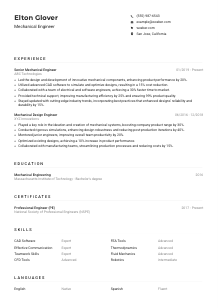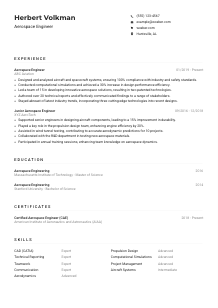Manufacturing Engineer Resume Example
Streamlining production, but your resume isn't cutting it? Assemble a sharper profile with this Manufacturing Engineer resume example, engineered using Wozber free resume builder. Explore how to optimize your manufacturing know-how to align with job demands, crafting a career trajectory that's as efficient as your assembly lines!
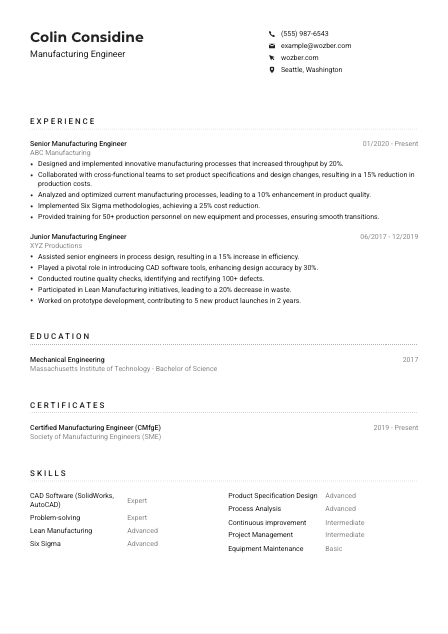
How to write a Manufacturing Engineer resume?
Greetings, aspiring Manufacturing Engineer! In the vast, competitive sea of job hunting, having a resume that stands out is akin to possessing a golden ticket. But not just any resume will do. You need one that sings your praises in perfect harmony with the job you're eyeing.
Using targeted strategies and the right tools like Wozber's free resume builder, we'll guide you to craft a resume that's like a well-oiled machine, tailored to the Manufacturing Engineer position you desire. This journey is about transforming your resume into a testament of your expertise, so get ready to showcase your skills in a way that resonates with hiring managers.
Personal Details
First impressions matter, and in the world of job applications, your Personal Details section is the handshake that starts it all. For a role as pivotal as a Manufacturing Engineer, aligning this section with the specific needs of your desired position is crucial. Here's how to polish your introduction to mirror professionalism and preparedness.
1. Name and Title
Your name isn't just a label; it's the marque of your professional brand. Use a clear, professional font and place your name at the top, unmistakably marking your identity. Right beneath your name, specify your targeted job title – 'Manufacturing Engineer'. This not only shows you're aligned with the role but also personalizes your resume for the desired job.
2. Contact Information
In the digital age, contact details go beyond just your phone number. Include a professional email address using a combination of your first and last name, and consider adding a LinkedIn profile to bolster your credentials. However, ensure that all contact points are current and professional. A misplaced digit or an outdated profile can mean a missed opportunity.
3. Match the Job Location
For position-specific relocate requirements like "Must be located in or willing to relocate to Seattle, Washington," directly listing 'Seattle, Washington' as your location (if true) instantly shows compatibility. This simple step can position you as a practical choice before a hiring manager even delves into your qualifications.
4. Professional Online Presence
Including a link to a professional website or a well-crafted LinkedIn profile offers an additional layer of depth to your application. Ensure that the content complements your resume, showcasing projects or endorsements that reinforce your candidacy for the Manufacturing Engineer role.
5. Privacy and Professionalism
Avoid including details that aren't directly relevant or could be used for discriminatory purposes, such as age, marital status, or photo. Keeping the focus on your professional capabilities ensures the employer's attention remains on what truly matters - your qualification for the Manufacturing Engineer position.
Takeaway
Think of your Personal Details section as your resume's headline banner. It should spark interest and invite the hiring manager into the professional story you're about to unfold. Ensuring it resonates with the Manufacturing Engineer role you aspire to will set a professional tone for the rest of your resume. Precision here primes for a polished first impression.





Experience
The Experience section is where your resume gets down to the nuts and bolts of your career. For a Manufacturing Engineer, this section must showcase not just where you've been, but how you've shone. Every bullet point is a chance to reflect your contribution and alignment with the specific role's requirements. Let's engineer this section to showcase your professional milestones.
- Designed and implemented innovative manufacturing processes that increased throughput by 20%.
- Collaborated with cross‑functional teams to set product specifications and design changes, resulting in a 15% reduction in production costs.
- Analyzed and optimized current manufacturing processes, leading to a 10% enhancement in product quality.
- Implemented Six Sigma methodologies, achieving a 25% cost reduction.
- Provided training for 50+ production personnel on new equipment and processes, ensuring smooth transitions.
- Assisted senior engineers in process design, resulting in a 15% increase in efficiency.
- Played a pivotal role in introducing CAD software tools, enhancing design accuracy by 30%.
- Conducted routine quality checks, identifying and rectifying 100+ defects.
- Participated in Lean Manufacturing initiatives, leading to a 20% decrease in waste.
- Worked on prototype development, contributing to 5 new product launches in 2 years.
1. Highlight Relevant Roles
Dive deep into the job description's requirements and align your experience with them. For a Manufacturing Engineer, roles that had you driving initiatives for quality enhancement, cost reduction, and team collaboration are particularly pertinent. Focus on experiences where your engineering prowess led to tangible successes.
2. Job Titles and Companies
Structure your experiences chronologically, spotlighting your journey through various roles and organizations. Highlight promotions or increases in responsibility. This not only shows growth but also your potential for leadership and initiative-taking within the sphere of Manufacturing Engineering.
3. Targeted Accomplishments
Instead of a list of duties, captivate with accomplishments. Use the STAR method (Situation, Task, Action, Result) to articulate your achievements. For example, "Analyzed manufacturing processes using Lean Manufacturing principles, resulting in a 25% reduction in waste and a 10% increase in productivity." This method paints a vivid picture of your capabilities and impact.
4. Quantify Success
Numbers speak volumes. Whenever possible, quantify your achievements to provide concrete evidence of your impact. Increased productivity by 20%? Reduced production costs by 15%? These figures offer a measurable testament to your skills and effectiveness.
5. Relevance is Key
Focus solely on experiences that underline your suitability for the Manufacturing Engineer role. Side projects or varied interests, while important, should take a backseat unless they directly contribute to your candidacy for this specific position.
Takeaway
Your Experience section is the foundation that supports your claim to the Manufacturing Engineer title. It's where you prove that you're not just a candidate, but the candidate for the job. Tailor it with precision to reflect the engineer you are, showcasing the defining moments of your career with clarity and impact. Remember, in this section, every word works hard to build your case.
Education
In the realm of Manufacturing Engineering, your Education section is more than a list of schools; it's the bedrock of your expertise. Here, your academic journey must align with the role's educational requirements, proving you have the theoretical foundation to apply your knowledge practically. Let's ensure your education reflects the cornerstone of your capabilities.
1. Degree Alignment
The job calls for a "Bachelor's degree in Mechanical Engineering, Industrial Engineering, or related field." Directly match your degree to this requirement if applicable. This demonstrates you have the requisite academic background and sets a solid foundation for the skills you bring to the table.
2. Structured Layout
Maintain a clean, straightforward listing of your educational background. Include your degree, the institution where you earned it, and graduation date. This structure allows hiring managers to quickly verify your academic credentials against their requirements.
3. Degree Specification
If your degree aligns perfectly with the job's prerequisites, make it known. For instance, listing 'Bachelor of Science in Mechanical Engineering' clearly states your qualification and specialty, directly connecting your education to the Manufacturing Engineer role.
4. Relevant Coursework
Though not always necessary for seasoned professionals, if you're new to the field, highlighting pertinent courses can illustrate foundational knowledge in key areas like SolidWorks or AutoCAD, Lean Manufacturing, and Six Sigma methodologies. This can bolster your resume by showing you have specific knowledge that aligns with job duties.
5. Additional Academic Achievements
Include honors, relevant extracurricular activities, or projects that demonstrate skills or interests directly connected to the demands of a Manufacturing Engineer. While not the focus for seasoned professionals, these details can add depth for early-career applicants.
Takeaway
Your education tells the story of your intellectual journey and lays the groundwork for your professional path. In the field of Manufacturing Engineering, where precision and expertise are paramount, how you present your academic achievements can significantly influence your resume's impact. Let your Education section be a testament to your readiness for the challenges and responsibilities of the role.
Certificates
In an ever-evolving field like Manufacturing Engineering, certifications can dramatically elevate your professional profile. They are your arsenal, proving your commitment to continuous learning and excellence. Let's strategize on showcasing your certifications in a way that underscores your expertise and dedication.
1. Identifying Key Certifications
While the job description may not explicitly demand specific certifications, adding ones relevant to Manufacturing Engineering can set you apart. For instance, a 'Certified Manufacturing Engineer (CMfgE)' credential immediately signals your advanced knowledge and dedication to the profession.
2. Selective Showcase
Quality trumps quantity when it comes to certifications. Highlight those that directly enhance your candidacy for a Manufacturing Engineer role. Each certificate listed should act as a beacon, drawing attention to your specialized skills and knowledge within the field.
3. Date Details
Especially for industry-specific certifications, providing the dates of attainment or renewal can showcase your current competencies and commitment to staying updated with professional standards. This temporal detail adds context and weight to your achievements.
4. Pursue Continued Learning
Manufacturing Engineering is a dynamic field. Actively seeking out further certifications not only broadens your skill set but also shows prospective employers your drive for professional growth. Keep your eye on industry trends and emerging technologies to identify valuable learning opportunities.
Takeaway
Your certifications are a testament to your dedication to your craft and willingness to go above and beyond the standard qualifications. They illuminate your resume, providing tangible evidence of your expertise and specialization in Manufacturing Engineering. Through careful selection and presentation of your certifications, you underline your exceptional suitability for the role.
Skills
Your Skills section is the toolbox of your resume – a concise display of the tools you have at your disposal to excel as a Manufacturing Engineer. Here, precision is key. Tailoring this section to reflect the skills sought in the job description not only showcases your qualifications but also speaks to your ability to address the role's specific needs. Let's fine-tune your skills list to make it a highlight of your resume.
1. Matching Job Description
Start by dissecting the job listing for skills and competencies the employer is seeking. For a Manufacturing Engineer, skills in "CAD software such as SolidWorks or AutoCAD," "Lean Manufacturing and Six Sigma methodologies," and "effective communication and problem-solving skills" are gold. Ensure these are prominently featured if they are in your repertoire.
2. Prioritize Relevant Skills
While it might be tempting to list every skill you've acquired, focus on those most relevant to Manufacturing Engineering. This targeted approach makes it easier for hiring managers to see your fit for the role at a glance. Distinguish between 'Expert' and 'Intermediate' levels to provide a clear picture of your proficiency.
3. Organized Listing
Keep your skills list neat and easy to scan. Group similar skills together or prioritize them based on the job description's emphasis. This organizational strategy ensures that hiring managers can quickly identify your key competencies without getting lost in a sea of text.
Takeaway
The Skills section of your resume is a testament to your professional competence and readiness for the challenges of the Manufacturing Engineer role. It's where you get to highlight the practical tools in your engineering toolkit. By carefully selecting and organizing your skills, you assure potential employers of your match for their needs and your potential to add value from day one.
Languages
In a Manufacturing Engineering role that might span across global teams or projects, your ability to communicate in multiple languages can be a significant boon. While the immediate job might require proficiency in English, showcasing additional language skills can offer a glimpse into your versatility and readiness for diverse work environments. Let's navigate the Languages section to emphasize your global communication competencies.
1. Confirm Necessity
Review the job listing for any explicit language requirements. For the Manufacturing Engineer role specified, "Ability to operate in an English-speaking work environment" is a must. Ensure your language proficiency in English is clearly stated.
2. Showcase Additional Languages
After highlighting your proficiency in the required language, list any additional languages you are fluent in. This can set you apart in the hiring process, especially if the Manufacturing Engineer role involves coordination with international teams or suppliers.
3. Clarity in Proficiency
When listing languages, be transparent about your level of proficiency using terms like 'Native', 'Fluent', 'Intermediate', and 'Basic'. This honesty helps set realistic expectations and showcases your integrity.
4. Global Perspective
Even if not directly relevant to the role's immediate requirements, additional languages highlight your capability to navigate multicultural environments. This can be particularly appealing in industries where global collaboration is key.
5. Role Relevance
Consider the broader context of the Manufacturing Engineer role. If it has a potential international scope, emphasizing your multilingual abilities could provide a competitive edge. Align this section with the role's demands and potential growth opportunities.
Takeaway
Your linguistic proficiency is more than just a list of languages; it's a showcase of your capability to engage and collaborate in a global engineering arena. Whether for practical communication needs or highlighting your adaptability, the Languages section adds a layer of depth to your resume. It's an opportunity to signal your readiness for opportunities that stretch beyond local borders and into the international sphere of Manufacturing Engineering.
Summary
Crafting an engaging Summary section is like delivering a compelling elevator pitch. It's your chance to grab the hiring manager's attention and succinctly convey why you are the perfect fit for the Manufacturing Engineer position. This section threads together your professional narrative, highlighting your strengths and setting the tone for the detailed achievements to follow. Let's dive into constructing a Summary that captivates and convinces.
1. Decode the Essence
Fully grasp the core competencies the job demands. A Manufacturing Engineer role centers on design, development, and improvement of manufacturing processes. Your summary should echo these responsibilities, presenting you as a proficient problem-solver with a knack for efficiency and quality.
2. Start Strong
Begin your summary with a self-assessment that reflects both your professional standing and your dedication to the Manufacturing Engineering field. For instance, stating that you're a 'dedicated Manufacturing Engineer with over 4 years of experience' immediately establishes your committed professional identity.
3. Highlight your Strengths
Focus on your key achievements and strengths that directly respond to the job's requirements. Mentioning success in "designing and improving manufacturing processes" or "implementing cost-reduction strategies" directly ties your experience to the employer's needs.
4. Keep It Precise
Aim for brevity while packing a punch. Your summary is a teaser, meant to entice the reader to delve deeper into your resume. Keep it concise, clear, and focused on your most compelling traits and accomplishments as a Manufacturing Engineer.
Takeaway
Your Summary is the spotlight moment for your resume. It introduces you, sets the stage, and incites interest. Crafting this section with care ensures that it reflects your qualifications for the Manufacturing Engineer role compellingly, offering a snapshot of your professional brilliance. Let it resonate with your enthusiasm and readiness for the challenges ahead, compelling hiring managers to invest in your potential.
Launching Your Manufacturing Engineer Journey
Congratulations on equipping yourself with the knowledge to craft a standout resume for the Manufacturing Engineer position! With these strategies and insights, coupled with Wozber's ATS-friendly resume template and free resume builder, you're now prepared to align your resume precisely with the job's demands. Remember, your resume is not just a document; it's a narrative of your professional journey, sculpted to showcase your best self. Harness your experiences, skills, and achievements, and let them pave the way to your next career milestone.
The world of Manufacturing Engineering awaits your expertise. Step forward with confidence, and let your resume open doors to new opportunities. Your journey to making impactful contributions starts now.

- Bachelor's degree in Mechanical Engineering, Industrial Engineering, or related field.
- Minimum of 3 years of experience in a manufacturing or production environment.
- Strong proficiency with CAD software such as SolidWorks or AutoCAD.
- Experience with Lean Manufacturing and Six Sigma methodologies.
- Effective communication and problem-solving skills.
- Ability to operate in an English-speaking work environment.
- Must be located in or willing to relocate to Seattle, Washington.
- Design, develop, and implement manufacturing processes and equipment.
- Analyze manufacturing processes for enhancement of quality, cost reduction, and throughput improvements.
- Collaborate with cross-functional teams to determine product specifications and design changes.
- Implement continuous improvement initiatives to optimize performance and reduce manufacturing costs.
- Maintain documentation and provide training for production personnel on new or modified equipment and processes.





